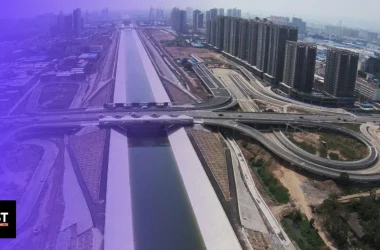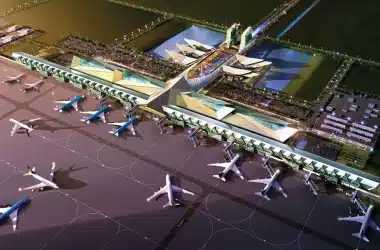The new government of Thailand is on track to turning a 400-year-old idea into reality. It was announced that the Thai Land Bridge construction will start in 2025, and the country is now in the process of acquiring foreign investment to fund the mega-project.
Can the current government succeed in what many others failed to do throughout centuries, and what impact will this project have on the Malacca Strait and Singapore trade? And will this project be the economic lifeline Thailand needs?
Thailand In The Belt And Road Forum
The third edition of China’s Belt and Road Forum for International Cooperation was held from October 17 to October 19 in Beijing. The forum is an international political and economic forum of the Belt and Road Initiative, which is China’s plan to invest in more than 150 countries and organizations.
Thailand’s Prime Minister, Srettha Thavisin, saw this event as the perfect opportunity to announce that Thailand was evaluating an enormous land bridge project in the south of the country. He explained that the bridge would be linking the Indian and Pacific Oceans with the aim of shortening shipping time between the two oceans by six to nine days.
The Prime Minister’s pitch was aimed at foreign investors, mainly Chinese and Saudi Arabian investors who have previously shown interest in the idea.
The proposal is very ambitious, requiring nearly $28 billion, and this amount will come from the private sector and foreign investment. The government will only deal with providing the land necessary for the project.
This project is ambitious, expensive, and quite possibly born out of the Thai government’s anxious need to transform the country from being middle-income to high-income by 2037, in the midst of an economic slowdown in Thailand and the world. But, it’s also important to note that the proposal is nothing new.
A 400-Year-Old Project
In fact, the concept of connecting the Gulf of Thailand with the Andaman Sea possibly goes back to the 17th century, when Thai King Narai first proposed the idea for a “Klong Thai” or Thai Canal. This idea piqued the interest of various governments throughout the centuries, including the Thai monarchy and colonial rulers. Many have tried to dig this canal and failed.
In modern times, China started seriously reconsidering the proposal. The Thai Canal aligned with China’s vision of a new global Maritime Silk Road. The canal would reduce China’s dependence on the Malacca Strait, a strategic waterway between Malaysia and Indonesia that most Chinese imports pass through. The waterway also makes a perfect chokepoint from India’s perspective, and India could easily block it if Chinese-Indian tensions rise.
This wasn’t the only benefit to China, because the canal would also connect to many different Chinese infrastructure and connectivity projects in the region.
That’s why in 2015, a coalition of the Thai Canal Association, a group of retired generals, politicians, and business executives, and the Thai-Chinese Cultural and Economic Association showed their support for the project and requested another feasibility study.
This caused Chinese media to report that China and Thailand had signed an agreement to build the canal through the Kra Isthmus, but both the Chinese and Thai governments denied this, and the project was once again shelved.
But this wasn’t the end for the stubborn plans of the project, and in 2018, Thailand’s prime minister ordered yet another feasibility study for the canal. In the same year, the Thai government announced that it was delaying the purchase of Chinese submarines that cost $724 million.
The submarine deal was agreed in 2017, and it caused public outrage in Thailand because the general public didn’t see why their government was investing in submarines while the country’s economy was declining.
Two years later, in 2020, Thailand announced that the canal project had been scrapped. The government didn’t think it was politically and economically viable. In addition to that, the Thai government had national security fears, and the project would’ve separated Thailand’s Malay Peninsula, which would’ve encouraged instability and insurgency in the southern provinces.
Another concern was the amount of influence and control China would’ve gotten from the project, as 80% of its oil imports pass through the Malacca Strait, and it’s also an important connection for China’s trade with Europe and the Middle East. Naturally, other trading countries, such as India and Singapore, opposed the project.
There were also concerns over the project’s threats to the environment. The proposed route for the canal would’ve brought devastation to habitats populated by endangered wildlife on both coasts and other biology diversity protected areas.
In the face of all this backlash, Thailand succumbed to the pressure and canceled the canal project, along with the submarine deal that was left hanging for three years.
Now, in 2023, the idea was revisited again in the form of the Thai Land Bridge. The prime minister gave a speech at an Economic Reporters Association meeting in October, revealing his enthusiasm about the project and the desire to see it finished during the current government’s term, believing that it will boost Thailand’s economy greatly and make the country an attractive country for foreign investment.
Why Thailand Needs The Land Bridge
It’s no surprise that the Thai government is so eager to finish a large-scale project like this one, as the economy needs a major boost. Over the past ten years, Thailand’s GDP grew by only 1.8% per year on average, and household debt increased from 76% of GDP to 91% at present. This especially causes concern for the country because Thailand’s household debt-to-GDP ratios are the highest in Asia and rank 10th globally.
This is just a portion of the challenges that Thailand faces. The country’s economic problems range from the short and medium-term to the long-term, according to Prime Minister Srettha Thavisin.
He said that solutions for short-term problems include debt suspension for 2 million small farmers, reducing energy costs, such as the power tariff to 3.99 baht per unit, and the implementation of a 20 baht fare for transit lines.
As for solutions for medium- and long-term problems, in addition to this project, the government decided to focus on signing as many free-trade agreements as possible with other countries, with the prime minister highlighting that there had been none in the past ten years.
He also recognizes the importance of bringing foreign investment to Thailand, and has visited many countries to invite foreign companies to invest in Thailand. He said that the reason Thailand fails to attract investors is its lack of good infrastructure and announced the government’s plans to invest more in infrastructure.
This need for foreign investment encouraged the government to emphasize the opportunities investors could find in the Thai Land Bridge project. The prime minister, the minister of foreign affairs, and the Federation of Thai Industries visited Saudi Arabia in June 2023, and the Arab country expressed an interest in investing in oil distribution centers within the Land Bridge project area in Southern Thailand.
In addition to Saudi Arabian investors, Chinese companies also showed interest. One company, China Harbour Engineering Co, is China’s largest infrastructure company and has done business in Thailand through a Thai subsidiary since 1994.
The project’s forecasts possibly drive the interest of investors. According to the Thai government, this project is expected to increase southern Thailand’s contribution to annual GDP to about 10%, from 2% currently, for at least ten consecutive years.
The project would also create 280,000 job opportunities in the southern Thai provinces Ranong and Chumphon, and cause a growth of 5.5% for the country’s economy, noting that growth for 2023 is estimated to be from 2.5% to 3.0%.
The government also announced that it will start receiving money from investors for the project in 2025, and construction will begin the same year. The project’s development will be done in phases, with the first phase finishing in 2030 and the last in 2039. By the end of this period, both ports linked by the bridge should be able to handle 20 million cargo containers on an annual basis.
Bridge Or Canal?
The Thai Land Bridge and the Thai Canal serve the exact same purpose, but what is the difference, and what makes one a better choice than the other?
It’s important to understand the main reason behind the canal project shutting down was fear for national security. Unlike the canal, the bridge doesn’t involve digging through the Kra Isthmus and causing political conflict by dividing the country, and that makes the bridge more viable.
This saves Thailand from internal conflict, but doesn’t make it safe from external ones. According to Dr. Yuttaporn Issarachai, a political scientist from Sukhothai Thammathirat Open University, Thailand could be inserting itself into the maritime territorial spats between China, Vietnam, and the Philippines by building near the disputed area.
Singapore and India also protested against the canal because of fear of a stronger Chinese presence in the Indian Ocean and because it would reduce the number of ships traveling through the Malacca Strait and Singapore. It was especially worrying because the maritime industry made up 7% of Singapore’s GDP in 2014.
The land bridge isn’t facing the same opposition as the canal. Perhaps because even though it will save time and distance for shipping, its impact on trade in the Malacca Strait and Singapore will be short-term.
The reason for this is that mariners are used to the Straits of Malacca and Singapore route, and it is equipped with adequate shipping facilities and services that must be considered and could offset the need to save time and/or distance.
However, the bridge doesn’t tick all the boxes as a perfect alternative for the canal, as it’s also accompanied by the same environmental concerns that the canal had. The Thai government has yet to conduct an environmental impact study properly, so the environmental consequences of the project are unclear.
The new Thai government has proven itself to be successful at acquiring foreign investment, especially from China, as Thailand received foreign investment applications worth $10.1 billion from January to August, with Chinese applications worth 90.3 billion baht.
This dependence on China might have negative consequences for Thailand due to the geopolitical tensions other countries in the region have with China, and, of course, the Western countries that Thailand wants to have as investors as well.
Disclaimer
Please visit and read our disclaimer here.









